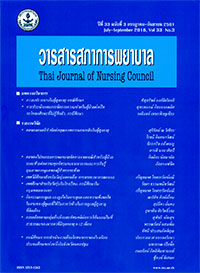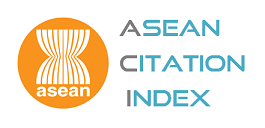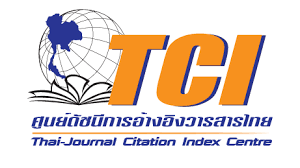การคล้อยตามกลุ่มอ้างอิงและทัศนคติต่อการให้นมแม่ในที่สาธารณะของมารดาที่มีบุตรอายุ 6-12 เดือน
คำสำคัญ:
การให้นมแม่ในที่สาธารณะ, ทัศนคติ, การคล้อยตามกลุ่มอ้างอิง, มารดาที่มีบุตร 6-12 เดือนบทคัดย่อ
วัตถุประสงค์: เพื่อศึกษาความแตกต่างของการคล้อยตามกลุ่มอ้างอิงและทัศนคติต่อการให้นมแม่ในที่สาธารณะของมารดาที่เคยให้นมแม่ในที่สาธารณะ และมารดาที่ไม่เคยให้นมแม่ในที่สาธารณะ
รูปแบบการวิจัย: การวิจัยเชิงบรรยายแบบเปรียบเทียบ
วิธีดำาเนินการวิจัย:กลุ่มตัวอย่างเป็นมารดาที่บุตรอายุ 6 -12 เดือน จำานวน 68 ราย ที่พาบุตรมารับวัคซีนที่คลินิกสุขภาพเด็กดี เก็บข้อมูลโดยใช้แบบบันทึกข้อมูลทั่วไป แบบสอบถามประสบการณ์การให้นมแม่ในที่สาธารณะ แบบสอบถามการยอมรับของบุคคลรอบข้างต่อการให้นมแม่ในที่สาธารณะ แบบสอบถามทัศนคติต่อการให้นมแม่ในที่สาธารณะ วิเคราะห์ข้อมูลด้วยสถิติ Mann-whitney U test และสถิติที
ผลการวิจัย: พบว่า มารดาที่เคยให้นมแม่ในที่สาธารณะและมารดาที่ไม่เคยให้นมแม่ในที่สาธารณะมีคะแนนการคล้อยตามกลุ่มอ้างอิงต่อการให้นมแม่ในที่สาธารณะไม่แตกต่างกันที่ระดับนัยสำาคัญทางสถิติ .05 (Z = -1.313, p = .189) อย่างไรก็ตามมารดาทั้ง 2 กลุ่มมีคะแนน
ทัศนคติต่อการให้นมแม่ในที่สาธารณะแตกต่างกันอย่างมีนัยสำาคัญทางสถิติ (t = -2.325,df= 66, p<.05) สรุปและข้อเสนอแนะ:จากผลการศึกษา พยาบาลควรให้คำาแนะนำามารดาเกี่ยวกับ วิธีการเตรียมตัวเพื่อให้นมแม่ในที่สาธารณะ รวมถึงให้คำาชมเชยและสร้างความมั่นใจเพื่อ
ส่งเสริมให้มารดาเกิดทัศนคติที่ดีต่อการให้นมแม่ในที่สาธารณะและสามารถให้นมแม่ในที่สาธารณะได้
Downloads
References
2. The Medical Record and Statistics Department, King Narai Hospital. Annual report. Lopburi: King Narai Hospital; 2015. (in Thai)
3. Department of Health, Ministry of Public Health. 5 flagship projects 2014 [internet]. 2014. [cited 2018 May 19]. Available from: https://164.115.
22.73/r9health/wp-content/uploads/2014/04/5-Flagship-Projects.pdf (in Thai)
4. Li R, Fein SB, Chen J, Grummer-Strawn LM. Why mothers stop breastfeeding: mothers’ self-reported reasons for stopping during the frst year. Pediatrics 2008; 122: 69-76.
5. Thomas J.S., Yu E.A., Tirmizi N, Owais A, Das SK, Rahman S, et al. Maternal knowledge, attitudes and
self-effcacy in relation to intention to exclusively breastfeed among pregnant women in rural Bangladesh. Matern Child Health J 2015; 19: 49-57.
6. Brown A, Raynor P, Lee M. Young mothers who choose to breast feed: the importance of being part of
a supportive breast-feeding community. Midwifery 2011; 27: 53-9.
7. Moore ER, Coty MB. Prenatal and postpartum focus groups with primiparas: breastfeeding attitudes, support, barriers, self-effcacy, and intention. J Pediatr Health Care 2006; 20(1): 35-46.
8. Meedya S, Fahy K, Kable A. Factors that positively influence breastfeeding duration to 6 months: a literature review. Women Birth 2010; 23(4): 135-45.
9. Hawley NL, Rosen RK, Strait EA, Raffucci G, Holmdahl I, Freeman JR, et al. Mothers’ attitudes and beliefs about infant feeding highlight barriers to exclusive breastfeeding in American Samoa. Women Birth 2015; 28: 80-6.
10. Boyer K. Affect, corporeality and the limits of belonging: breastfeeding in public in the contemporary UK.Health Place 2012; 18(3): 552-60.
11. Li R, Rock VJ, Grummer-Strawn L. Changes in public attitudes toward breastfeeding in the United States,1999-2003. J Am Diet Assoc 2007; 107(1): 122-7.
12. Brown A, Davies R. Fathers’ experiences of supporting breastfeeding: challenges for breastfeeding promotion and education. Matern Child Nutr 2014; 10:510-26.
13. Scott JA, Diet GD, Kwok YY, Synnott K, Bogue J, Amarri S, et al. A comparison of maternal attitudes to breastfeeding in public and the association with breastfeeding duration in four European countries: results of a cohort study. Birth 2015; 42(1): 78-85.
14. Ajzen I. Attitudes, personality, and behavior. Milton Keynes : Open University Press; 1988.
15. Phattharayuttawat S. Manual of psychological testing 5th. Bangkok: Department of Psychology, Faculty
of Medicine Siriraj Hospital; 2008. (in Thai)
16. Walingo MK, Mutuli LA. Influence of maternal beliefs, attitude, perceived behavior on breast-feeding among
post partum mothers in western Kenya. Pakistan Journal of Nutrition 2014; 13(5): 250-4.
17. MacKean G, Spragins W. The challenges of breastfeeding in a complex world [internet]. 2012. [cited 2018 May 19]. Available from: https://www.albertahealthservices.ca/ps-1029951-pregnancy-2012-breastfeeding-lit-review.pdf
18. Borenstein M, Hedges LV, Higgins JPT, Rothstein HR. Introduction to Meta-Analysis. Chichester, West Sussex, UK: Wiley; 2009.
19. Siriwannabut P. Theories of developmental psychology. 6th ed. Bangkok: Chulalongkorn University Press; 2013. (in Thai)
20. Hohl S, Thompson B, Escareño M. Cultural norms in conflict: breastfeeding among Hispanic immigrants in rural Washington State. Matern Child Health J 2016; 20(7): 1549–57.
21. Sriraman NK, Kellams A. Breastfeeding: what are the barriers? Why women struggle to achieve their goals. J Womens Health (Larchmt) 2016; 25(7): 714-22.
22. Keely A, Lawton J, Swanson V, Denison FC. Barriers to breast-feeding in obese women: a qualitative exploration. Midwifery 2015; 31(5): 532-9.
23. Forster DA, McLachlan HL. Women’s views and experiences of breast feeding: positive, negative or just good for the baby? Midwifery 2010; 26(1): 116-25.







